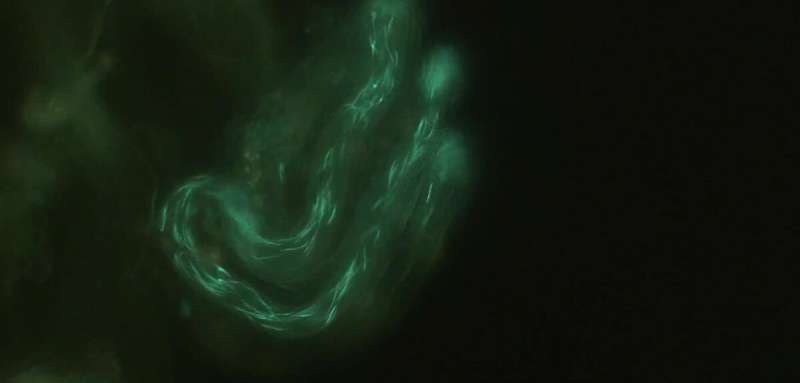Fruit fly sperm inside a female’s specialised sperm storage organ. Credit: University of Oxford
Researchers at the University of Oxford have discovered that male fruit flies adjust their seminal fluid depending on the levels of competition from other males.
When more rivals are around, they create and add extra protein to their seminal fluid making it extra potent. This boosts the number of offspring their partners produce, but the extra effort comes at a cost: it tires the male out and makes him sluggish to remate.
It previously wasn't known if sperm and seminal fluid could be changed independent of each other, but this research shows that it can.
Humans also transfer both sperm and seminal fluid during ejaculation and this finding could suggest a new understanding of factors affecting fertility. It may also suggest novel treatment avenues for the current male "fertility crisis," evidenced by human sperm counts declining steeply over the past 40 years.
The researchers' data, published today in PNAS, suggest that male fruit flies use different rules for changing different parts of semen. If exposed to one or many rivals the researchers observed increases in sperm transfer compared to zero rivals. However, with seminal protein they observed increases in protein transfer in the presence of many compared to one or zero.
Lead researcher, Dr. Ben Hopkins, from the Department of Zoology, University of Oxford, said: "It reminds us that seminal fluid is a key mediator of reproductive success. It also shows that the amount of seminal proteins males transfer is variable, changing in response to the social environment."
"Males are prudent and responsive. They use the number of rivals around them to predict the threat of sperm competition—the battle between the sperm of rival males for fertilizations—and then adjust their ejaculates accordingly."
The occurrence of males changing what they put into their ejaculate to meet the demands of competition is known as "plastic" or "strategic" ejaculate allocation.
Credit: University of Oxford
Males in some species, including humans, transfer millions more sperm than are required for successful fertilization, which is thought to be a product of sperm competition: if a female mates with multiples males then a male can boost his fertilization success by transferring more sperm than his rivals.
The logic of plastic ejaculate allocation is that it's only worth transferring all that sperm if competition is likely. If males can predict the threat of competition then they can transfer a smaller ejaculate, and ultimately save their limited reserves of sperm for future matings. But researchers didn't know whether this same logic held true for other parts of the ejaculate. This work suggests that it does, but the rules for seminal proteins are different than for sperm.
Ben Hopkins said: "While transferring lots of seminal proteins gives males an advantage in competitive situations, it comes at a cost: they transfer relatively lower quantities in future matings, and as a result produce relatively fewer offspring, and making all that protein seems to tire them out."
Among the >100 different types of fruit fly seminal fluid proteins the team analyzed there was variation in response to competition with some showing much larger changes than others. The reasons for this will need further research, but the scientists believe that it's likely to relate to the diverse functions carried out by different parts of the seminal fluid in females. Some of these functions include changing what females eat, how often they sleep, and making them less sexually active, as well as influencing female sperm use and egg-laying.
This non-sperm component of the ejaculate is emerging as a major player, not just in relation to fertility outcome, but also in relation to female reproductive health.
This study shows that:
- Males can independently change the quantity of sperm and seminal protein they transfer to females in response to the presence of other males.
- The quantity of seminal protein a female receives changes the number of offspring she produces.
- Transferring lots of seminal protein in one mating reduces the quantity a male can transfer in his later matings.
It therefore demonstrates that it's not just the presence of seminal proteins that affects fertility, but also variation in the specific quantities she receives. These fertility effects act above and beyond variation in sperm number.
The data in this study raises the possibility that human ejaculates may also show broader and more sensitive changes in response to social stimuli than we currently appreciate. Understanding how social effects influence ejaculate composition could help us in the design of ejaculate collection procedures for use in human IVF and other assisted reproductive technologies.
More information: Ben R. Hopkins el al., "Divergent allocation of sperm and the seminal proteome along a competition gradient in Drosophila melanogaster," PNAS (2019). www.pnas.org/cgi/doi/10.1073/pnas.1906149116
Journal information: Proceedings of the National Academy of Sciences
Provided by University of Oxford
























